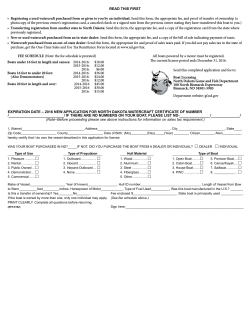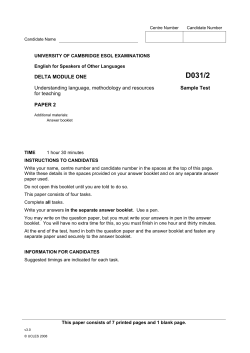
Seamanship Manual B. Sailing SEA SCOUT BASE ~ Sandvlei ~
SEA SCOUT BASE ~ Sandvlei ~ Seamanship Manual B. Sailing Pages 28-43 Watermanship 28 SEA SCOUT BASE – SANDVLEI Telephone / Fax : 021 – 788 7581 7950 P.O. Box 280, Muizenberg NAME : _____________________ Course GROUP : _____________________ Hours Required Watermanship Boatman Sailing 10 hours 10 hours 10 hours Course Helmsman W.C. Certificate Hours Required 10 hours 20 hours BOAT LOG DATE CREW REMARKS Hours completed and confirmed by the Port Captain (within 3 months of completing the course) _____________________ Port Captain Time Logged Sailing 29 TYPES OF SAILING CRAFT: DABCHICK THE DUCK FIREBALL FLIPPER Sailing 30 FLYING DUTCHMAN LASER MIRROR OPTIMIST Sailing PHANTOM SPROG 31 SONNET Sailing 32 ROPEWORK: 1. Reef Knot 3. Figure of Eight A flat, secure knot, best known for tying parcels and triangle bandages. Used to tie ropes of the same thickness together. A single strand Stopper Knot, usually when only a temporary stopper is required. PARTS OF A SAILING DINGHY: Sailing 33 PARTS OF THE SAIL AND RIGGING: Sailing 34 SAILS AND RIGGING: SAILS: STORM SAIL Special sails for stormy weather conditions and strong winds. These are both smaller and made from heavier material than normal sails. HEAD SAILS Any sails set before the foremast or main mast, if there is no foremast. FORESAIL Is the sail immediately before the foremast or main mast. JIB Any head sail set before the foresail. TRISAIL A triangular sail which is set abaft the foremast or main mast. (except the MIZZEN). STAYSAIL Any triangular sail whose luff is supported by a stay. RIGGING: 1.STANDING RIGGING:Consists of any wire or rope whose purpose is to support or make fast spars and masts. SHROUDS Shrouds support the mast on either side. STAYS Stays support the mast fore and aft. FORESTAY Forestay supports the mast forward. BACKSTAY Supports the mast aft, especially on larger yachts where there is a great deal of pressure forward due to the large sails that they carry. CHAIN PLAT ES These are fitted to the deck or side of the hull to which shrouds and stays are attached with metal turnbuckles or rope lanyards. TURNBUCKLE Used for adjusting the tension of the shrouds and stays. LANYARDS A short length of rope used to adjust the tension of the shrouds and stays on a dinghy. 2.RUNNING RIGGING: All running gear, that is, all ropes and wires that pass through pulleys or over sheaves. PULLEY Grooved wheel fixed in a block, enabling weights to be raised by a downward pull on the cord running in the groove. SHEAVE Grooved wheel, as in a pulley, but mounted in the mast or spar or on deck. HALYARDS Ropes or wires running through pulleys or sheaves fixed to the top of the mast, used to haul the sail to the top of the mast. There are the following halyards : MAIN, PEAK, THROAT, JIB, STAYSAIL. CLEATS Halyards are fastened to cleats. Sailing 35 MAIN SHEETS Main sheets are used to control the main sail. JIB SHEETS These are used to control the jib and foresail. These pass through sheaves or deadeyes which are wooden rings with a short length of rope spliced around it, the other end of the rope is fastened to the thwart riser, or passed through the crutch socket. DOWN HAUL A lightweight tackle to haul down the tack of the sail in order to tighten the luff. KICKING STRAP Used to hold down the boom, preventing it from lifting, especially when running before the wind. TOPPING LIFT This is used to lift the after end of the boom as in the case of the mizzen when not in use. HORSE A curved metal bar or track along the top of the transom to accommodate the traveller. TRAVELLER A sliding block fitted to the horse to which the main sheet block is shackled. BOOM A spar to stretch the foot of a sail. GOOSENECK A universal joint attaching the boom to the mast. GAFF A spar to which the head of the sail is laced on a gaff rigged yacht. HOUNDS The attachment point where the shrouds and stays are fixed to the masthead. PISTON HANKS A patent fitting used to attach the foresail to the forestay. TWIST HANKS As above Sailing FOLDING THE MAINSAIL: 36 Sailing 37 REEFING: Heavy Weather The good sailor will make an assessment of all sources of information available to avoid being caught out in really bad weather conditions, but there are bound to be times when a boat is pressed too hard by the wind. In such circumstances, there are a number of things to do, depending on the boat’s course relative to the wind, and whether or not it has an engine. If it is running downwind, or on a reach, you can turn into the wind, get the mainsail down, and carry on under jib alone. If your course is to windward, you may have to keep both sails up to preserve the balance of the sail plan, but reduce the total sail area. In other words, you have to REEF. Reefing The basic operation when reefing is to reduce the area of the mainsail. This is done in one of two ways, depending on what kind of reefing gear the boat has. The traditional way is to use reefing points, which are horizontal rows of short lengths of line hanging from the sail on either side of it. There are usually two or three rows between the foot and a third way up it, and at each row there is a cringle called a reefing cringle. To reef, means that you must lower the sail half a metre or a metre to one of the rows of reefing points, then retying the sail along the boom. Sailing 38 THEORY OF SAILING: POINTS OF SAIL: HANDLING A SAILING CRAFT: Beating to windward: Attempting to reach a windward mark as quickly as possible is not always achieved by pointing the boat as high as possible into the wind. Always remember that the boat must be kept moving as fast as possible with the advantage in working to windward. While it is undoubtedly an advantage to be able to point high, it is possible to kill the boat’s speed by pointing too high, with the sails sheeted in too hard. In gusty weather, it pays to head up as the boat heels with each gust and bear off slightly as the wind is spilled and the craft rights itself. In this way, ground can be made to weather in a series of steps while at the same time maintaining the speed of the craft. Remember, more weather helm can be induced while sailing close hauled by moving the crew’s weight forward, this also tends to give the bows a better grip on the water and due to the hull shape, the boat tends to point higher. Sailing 39 Tacking or going about: When tacking, do not force the tiller over suddenly. Sail the boat about by moving the tiller smoothly over to leeward, allowing the crew to back the jib only long enough to ensure the head is swung through the wind before the sheet is hauled taught on the opposite tack. Try to perfect your tacking, so that the boat comes about on the new tack without losing headway. If you do get into irons, and the boat begins to drift back, reverse your tiller immediately until her head swings onto the new tack. Reaching: This is the fastest point of sailing. Crew weight should be arranged so that the boat is trimmed level fore and aft. The centreboard should be raised to reduce excess weather helm and the sails should be eased until just before the point where the luff starts to back. On this point of sailing, more speed can be obtained, particularly with a dinghy that is fast enough to lift up on her bow wave and plane, by hauling on the sheets slowly, heading windward on a dying puff, then paying off slightly when a fresh gust hits the boat. If done correctly, the boat can be kept up on a plane for long distances. Running: Keep the wind on the opposite quarter to the side on which the mainsail is set with the mainsheet full out. Use only a few centimetres of centreboard, unless she starts to roll, in which case the centreboard should be lowered until the boat is again stable. Arrange the crew equally on both sides of the boat, the helmsman sitting leeward. Trim the boat fore and aft. Should the boat gybe unexpectedly, the helmsman is in the position to correct any tendency to broach and with half the crew sitting to weather, the other half of the crew have a chance to get to weather if necessary. Gybing: A controlled gybe in normal weather is a relatively easy manoeuvre. Haul in the mainsail slowly until approximately half in. Move the tiller smoothly to windward, at the same time have the mainsheet hand grasp the mainsheets and swing the boom across to coincide with the wind shifting direction from one quarter to the other across the stern. It is good seamanship to come about, when unsure that a gybe can be effected safely in a strong wind, by heading up and tacking, then bearing up on the new tack, rather than risking damage to rigging with an uncontrolled gybe. A fair indication that you may be letting yourself in for an uncontrolled gybe, is when the boom tends to lift, prevent this by bringing the wind fuller on the windward quarter. However, remember the faster a boat is travelling with the wind, the less wind force there is in the sail. A competent helmsman can effect a controlled gybe while on a full plane. Beware of dropping the centreboard when about to gybe in heavy weather, as this will increase weather helm and possibly induce a broach. Sailing 40 COMING ALONGSIDE: In making a landing or in picking up a mooring, the object is to sail the boat to the point where she will sail no more, in other words, in irons. This should be the position where it is estimated that her own momentum will carry her forward to the desired location. It takes practice to learn boat habits and the distance of shooting under different wind velocities. Sailboat landing, leeward side of dock: Made whenever possible in preference to windward landing (see figure 1 & 2). Lines and fenders ready at all times. Immediately dock is made, raise centreboard, lower jib, let sheets run. Take current (if any) into consideration on these landings. If wind is light, use all canvas. If wind is strong, use jib only. Figure 1 Figure 2 Getting away from dock, leeward side: Pay off bow, using jib until on the wind. Set sail (Figure 3). Figure 3 Sail bow around on jib until o n wind, sail astern while holding bow on line until jib can be used to complete manoeuvre to get on the wind. (Figure 4). Figure 4 Sailboat landing, windward side of dock: Not recommended for novices. Anchor and drop leeward on anchor line or cable. (Figure 5) Figure 5 Figure 6 If wind is not too strong, set boat away and abreast to windward. Let sheets run or douse sail. Wind on hull will bring her in. In this event, proper fending with fenders, feet or boat hook is indicated. Extreme care is used. To get away on the windward side, use anchor line to pull boat into position. Pay ahead around to desired tack. (see Figure 6). Sailing 41 MAN OVERBOARD – Recovery Procedure: If a crew member falls overboard, immediately one of the crew should be detailed to keep a bearing on him and if a marker is available, this should be thrown out. If beating or reaching – wear the craft around, gybe and approach him close hauled, luffing up alongside (see figure 3). If running before the wind, continue for a short distance, bear up, then tack to come up just leeward of the man before luffing up and coming alongside. (see figure 4). Remember that some of the crew should be detailed to balance the boat while the man is being hauled aboard. Figure 3 Figure 4 CAPSIZE DRILL: Slowly, almost majestically, the boat heels over and keeps heeling, and suddenly you and your crew are in the water. There are now three things you must NOT do: • • • Panic Swim for shore Argue over whose fault it was Here, on the other hand, are things you should do: • Stay with the boat, however unattractive it may look at the moment. Most modern sailboats have built-in buoyancy and will not sink. If you hang on, neither will you. • Slip into your lifejackets if you are not already wearing one. • Now, count heads. Is everyone safe and ready for action? Does anyone need help? • If you have capsized close to shore, you may be able to get a line on the boat and work it into shallow water, then right it in relative comfort and safety. • If rescue vessel is approaching, stand by to co-operate with the crew when they arrive. Sailing 42 If your boat is in deep water or a long way from shore or if there is no help on the way, and if everyone is in good shape, you can have a go at righting the boat yourself. Firstly, uncleat and free up all sheets. Round up all loose equipment floating around that someone forgot to secure and secure it. Next, work the boat until the bows are into the wind, stand on the tip of the centreboard and heave down on one gunwhale. The boat may slowly come erect sails and all. If it does, it’s bailing time. Bail vigorously with a bailing scoop, can, bucket or bilge pump, assuming any of these survived the capsize. If nothing did, bail by hand. Some cockpits are self-bailing. When the boat is stable and water mostly gone, climb on board over the stern and get under way again. If the boat won’t come upright with the sails on, no matter what you do, you’ll have to get them off. Let the mainsail outhaul go, free the tack from the boom, cast off the halyards and then work the sail down the mast, along the boom and jibstay. When they are free of the boat, bundle them up and lash them to a cleat or the mast. Secure the halyard, then stand on the centreboard and heave the boat upright. When it’s up, bail out the water and bend on the sail again. Congratulate yourself and the crew on doing it the hard way. Special Caution: Don’t try and swim ashore for help unless the beach is very close. Even if you’re a good swimmer, you may not make it – especially if the water is cold or rough. Exceptions: If the boat is on fire or if it is drifting towards a dam spillway or dangerous surf, you won’t have a choice. Get to shore. Sailing 43 SAILING – DEFINITION OF TERMS: Weather Helm A boat is said to carry a weather helm if, with the helm amidships, she tends to turn into the wind. Lee Helm A boat is said to carry a lee helm if, with the helm amidships, she tends to pay off from the wind. Close Hauled A boat is close hauled if, sailing with her sheets hauled in and her sails drawing, she is sailing as close to the wind as she can lie, with advantage in working to windward. Sailing Free A boat is sailing free whenever her sails are filled and she is not sailing close hauled. Reaching A boat is reaching when she is sailing free with the wind abeam or before the beam, but is not sailing close hauled. Close Reach (Fetching) When nearly close hauled. Broad Reach With the wind full on the beam. Running When she is sailing with the wind abaft the beam. Port Tack A boat is on port tack when the wind is on her port side. Starboard Tack A boat is on starboard tack when the wind is on her starboard side. Tacking (going about) A boat is tacking from the moment she is beyond head to wind until she has borne away, if beating to windward, to a close hauled course or if not beating to windward, to a course on which her mainsail is filled. On a Tack A boat is on a tack except when she is tacking or gybing. Beating Sailing close hauled on a series of alternate tacks to reach a windward destination. Gybing Altering course when running before the wind. A boat begins to gybe at the moment when, with the wind abaft, the foot of her mainsail crosses the centre line and completes the gybe when the mainsail fills on the other tack. Bearing Away Altering course away from the wind until the boat begins to gybe. Running by the lee A boat is running by the lee when she is running with her mainsail set on the windward side. Luffing Altering course towards the wind until head to wind
© Copyright 2025













